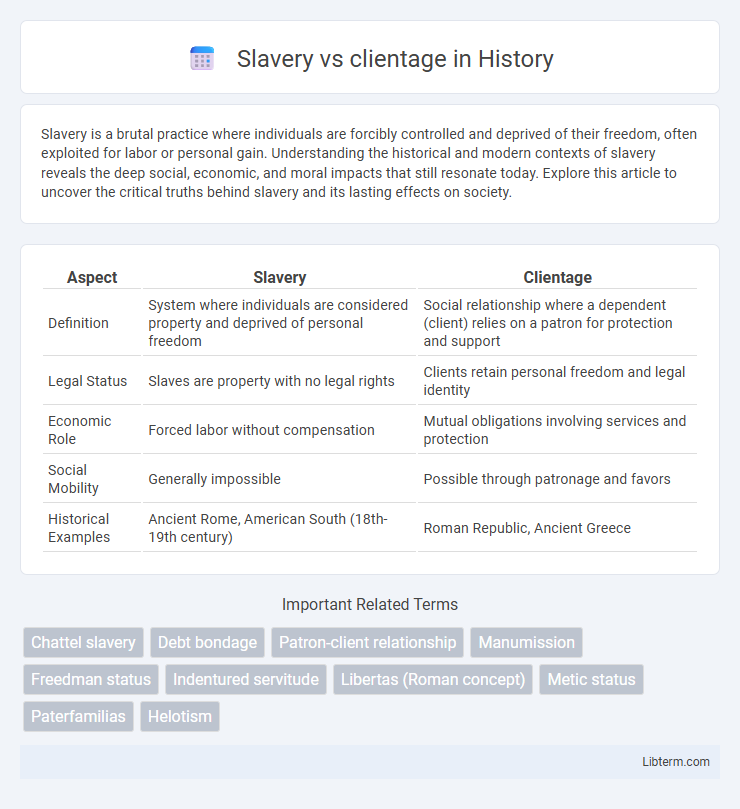Slavery is a brutal practice where individuals are forcibly controlled and deprived of their freedom, often exploited for labor or personal gain. Understanding the historical and modern contexts of slavery reveals the deep social, economic, and moral impacts that still resonate today. Explore this article to uncover the critical truths behind slavery and its lasting effects on society.
Table of Comparison
| Aspect | Slavery | Clientage |
|---|---|---|
| Definition | System where individuals are considered property and deprived of personal freedom | Social relationship where a dependent (client) relies on a patron for protection and support |
| Legal Status | Slaves are property with no legal rights | Clients retain personal freedom and legal identity |
| Economic Role | Forced labor without compensation | Mutual obligations involving services and protection |
| Social Mobility | Generally impossible | Possible through patronage and favors |
| Historical Examples | Ancient Rome, American South (18th-19th century) | Roman Republic, Ancient Greece |
Introduction to Slavery and Clientage
Slavery involves complete ownership of individuals as property, depriving them of personal freedom and legal rights, whereas clientage refers to a socio-political system where clients offer services or loyalty to a patron in exchange for protection or benefits. Slavery is characterized by coercion and lack of autonomy, while clientage operates through reciprocal obligations within hierarchical relationships. Understanding these distinctions highlights the varying degrees of dependence and control in ancient and classical societies.
Historical Backgrounds of Slavery and Clientage
Slavery, rooted in ancient civilizations like Mesopotamia and Egypt, involved the outright ownership and forced labor of individuals considered property, often acquired through warfare, debt, or birth. Clientage, prominent in Roman and medieval societies, established a patron-client relationship characterized by mutual obligations without full ownership, where clients depended on patrons for protection and economic support. Both systems reflect complex social hierarchies but differ fundamentally in legal status and personal freedoms of the individuals involved.
Legal Definitions and Social Status
Slavery is a legal institution wherein individuals are considered property and deprived of personal freedom, with laws enforcing ownership and control over slaves. Clientage denotes a social and legal relationship between a patron and a client, where the client retains personal freedom but owes services or obligations to the patron. The key distinction lies in slavery's absolute loss of legal personhood and autonomy, whereas clientage maintains the client's legal identity despite dependent social status.
Rights and Limitations: Slaves vs Clients
Slaves were legally considered property with no personal rights, subjected to forced labor and complete control by their owners, whereas clients maintained a degree of personal autonomy and possessed defined legal protections under patronage systems. Slavery imposed severe limitations, including lack of freedom, inability to own property, and no legal recourse, while clients retained some rights such as owning property, marrying freely, and engaging in economic activities. The legal distinctions between slaves and clients were central to ancient societies, shaping social hierarchy and individual freedoms in contrasting ways.
Economic Roles and Functions
Slavery and clientage shaped ancient economies through distinctive roles: slaves provided forced, unpaid labor critical for agriculture, construction, and domestic tasks, fueling the wealth of elites and state power. Clientage involved reciprocal obligations where clients offered services, political support, or labor in exchange for protection or resources from patrons, creating networks of socio-economic dependency and stability. These systems structured labor allocation and resource distribution, influencing production modes and the social hierarchy within their respective societies.
Family Life and Personal Autonomy
Slavery imposed severe constraints on family life as enslaved individuals faced forced separations and lacked legal recognition of familial bonds, undermining personal autonomy. In contrast, clientage systems allowed for more stable family structures and some degree of self-determination within hierarchical relationships. The difference in these social institutions critically shaped the autonomy and cohesion of family units in ancient societies.
Pathways to Freedom: Manumission and Social Mobility
Manumission offered enslaved individuals a critical pathway to freedom, often through legal decrees, self-purchase, or the benevolence of owners, enabling gradual social mobility within ancient societies. Clientage, a system where freed slaves or lower-status individuals entered patron-client relationships, facilitated integration into social hierarchies by providing protection and economic support in exchange for loyalty and service. These pathways highlight the complex intersections of dependency, freedom, and social stratification in classical and pre-modern civilizations.
Cultural Perceptions and Social Stigma
Slavery historically embodies a severe social stigma, rooted in the perceived loss of autonomy and dehumanization, often justified by racial or ethnic hierarchies. Clientage, contrastingly, involved a more reciprocal relationship with cultural acceptance, typically defined by mutual obligations within social strata rather than outright ownership. Varied cultural perceptions influenced the societal roles and limitations imposed on slaves and clients, affecting identity, status, and social mobility.
Key Differences Between Slavery and Clientage
Slavery involves absolute ownership of individuals who lack personal freedom and are compelled to work without compensation, whereas clientage is a social system based on mutual obligations between patrons and clients, granting clients limited autonomy. Slaves have no legal rights and are treated as property, in contrast to clients who maintain some legal status and can negotiate their duties. The key distinctions lie in the absence of personal freedom and legal personhood in slavery, compared to the relational and often reciprocal nature of clientage.
Legacy and Impact on Modern Societies
Slavery established a long-lasting legacy of racial inequality and systemic oppression that continues to influence social and economic disparities in modern societies. Clientage, often characterized by mutual obligations between patrons and clients, shaped social structures of dependency and power dynamics that persist in contemporary patronage and political networks. Both systems have contributed to entrenched hierarchies, affecting issues of citizenship, rights, and social mobility in present-day communities worldwide.
Slavery Infographic

 libterm.com
libterm.com